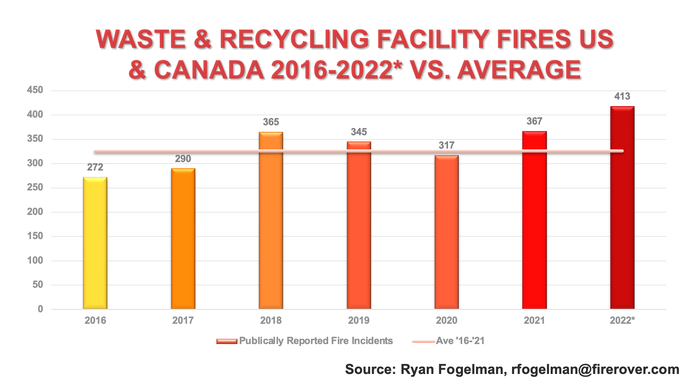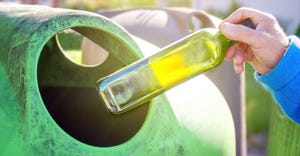Can TikTok Help The Industry Reduce Fires Through Education?
TikTok is the new Google, according to various news outlets, but can it be a new educational tool for the waste and recycling industry? Read on to learn more about the platform’s potential.

This year has been the worst year for fires since I began reporting waste and recycling facility fire incidents in 2016. In May and June, we incurred 99 reported fire incidents, the worst we have seen in any two-month period. That averaged 1.5 publicly reported fire incidents each day, but that changed in July when we finally saw a bit of a reprieve. In July, we experienced 32 publicly reported fire incidents in the U.S. and Canada. Still more than our 28 per month average, but less than the highs in April, May and June. Nineteen of these fire incidents occurred at waste, paper and plastic facilities; 8 occurred at scrap metal facilities; two occurred at rubber recycling facilities; and one each occurred at organics, e-scrap and hazmat operations. At Fire Rover, we responded to more than 100 fire incidents at our clients’ facilities.

My data only includes the fire incidents that were “reported” by a news outlet, and since I began analyzing this data in 2016, 2022 is turning out to be the worst year for reported fire incidents. Looking at the number of fire incidents using year-to-date (YTD) numbers, 2022’s 241 reported incidents are outpacing all prior years, including last year’s spike and 2018’s lithium-ion battery wave.

If we continue on the current trend, 2022 will by far outpace any of the previous years by 50 fire incidents.
What does the public really know about recycling?
In last month's article, I took a deep dive into one of the topics that I believe is a major contributing factor to fires: heat. It is not a coincidence that when we see hot and dry environments, we tend to experience more fires at our waste and recycling facilities. So, I can honestly tell you that I was taken aback by some of the comments and emails that I received lambasting me for “spreading the climate change lie.”
There is no denying that the past few years have been hotter and drier than previous years and that these factors have led to an increase in the number of fires happening in our waste and recycling facilities. I pray for my children that this is just a cycle and colder times are ahead to balance these times, but the hotter and drier climate doesn’t seem to be going away anytime soon.
What does the average American think about recycling?
There have been a ton of resources spent by the industry, associations, local municipalities and others trying to get the word out about proper recycling. However, are the label laws working to drive out confusion on what materials can be recycled and whether the public truly understands, or cares, about the effects they are having on our waste and recycling operations?
If you know me personally, you know that I am not one to just look at the status quo and be satisfied with the answer. Additionally, I have experience that goes well beyond the waste and recycling industry. I do not say that as a knock on the amazing folks in our industry but as a voice of reason when it comes to truly understanding the problem we face.
To understand what is going on with the American public, we send out emails and online surveys, but there is a place most of us have never thought to look to get a hold of reality and what is really going on—social media.
Social media, as we know it, has been under a major shift. Facebook, Instagram and Twitter are all losing their luster to TikTok. If you follow TikTok, it seems like a montage of videos that can make certain generations crazy, but to really understand the platform, you need to look at the comments section of each post. In the comments, there are certainly goofs and those who make sarcastic, but as you peel back the layers, there is a ton of good information that provides a perfect place to educate the public on effective recycling.
The issue is that the early adaptors are on TikTok, but most of the industry is slow to move our messaging to the platform in any major way. Very few businesses, municipalities and associations have embraced the benefit, but those that do will find a very engaged group of the public that is open to learning the truth a good number of us are trying to share.
Conclusion
Check out Fire Rover’s TikTok page where I am doing my best to share the harmful effects of improper recycling on our waste and recycling streams. As mentioned above, the videos are not what is important to those of us wanting to get a good grasp of the public’s understanding of recycling. Dig into the comments—shake your head at the childish ones but listen to what is being said. The traditional ways of marketing need to be updated to reach this generation of users who like short, fast videos that grab their attention. And once it is grabbed, you only have seconds to get your message across. While the video gets their attention, ongoing engagement is key and having an expert’s opinion paired with real questions is where the education can take place.
Ryan Fogelman, JD/MBA, is vice president of strategic partnerships for Fire Rover. He is focused on bringing innovative safety solutions to market, and two of his solutions have won the distinguished Edison Innovation Award for Industrial Safety and Consumer Products. He has been compiling and publishing the “Reported Waste & Recycling Facility Fires In The US/CAN” since February 2016 and the “Waste & Recycling Facility Fires Annual Report.” Fogelman regularly speaks on the topic of the scope of fire problems facing the waste and recycling industries, detection solutions, proper fire planning, and early-stage fire risk mitigation. Additionally, Fogelman is on the National Fire Protection Association’s Technical Committee for Hazard Materials. (Connect with Ryan on LinkedIn at https://www.linkedin.com/in/ryanjayfogelman or email at [email protected])
About the Author
You May Also Like




